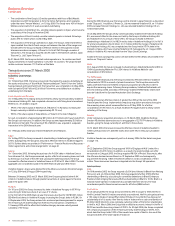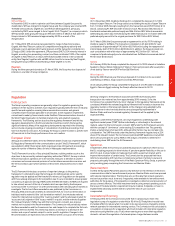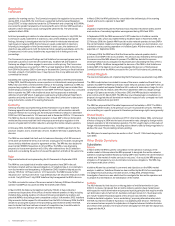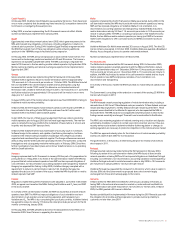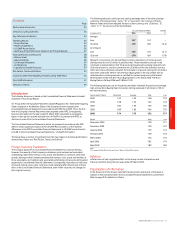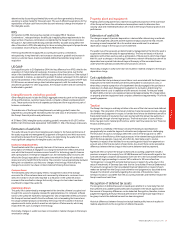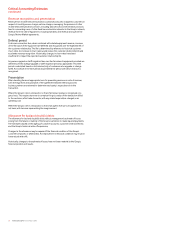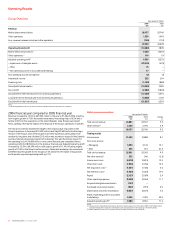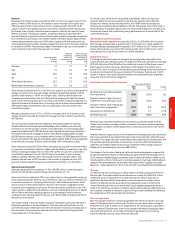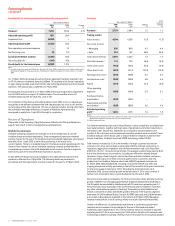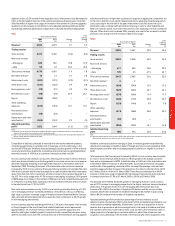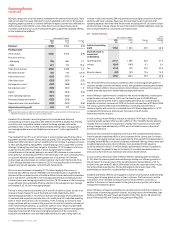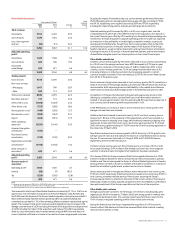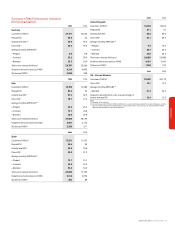Vodafone 2006 Annual Report Download - page 29
Download and view the complete annual report
Please find page 29 of the 2006 Vodafone annual report below. You can navigate through the pages in the report by either clicking on the pages listed below, or by using the keyword search tool below to find specific information within the annual report.
Vodafone Group Plc Annual Report 2006 27
Property, plant and equipment
Property, plant and equipment also represent a significant proportion of the asset base
of the Group and hence the estimates and assumptions made to determine their
carrying value and related depreciation are critical to the Group’s financial position and
performance.
Estimation of useful life
The charge in respect of periodic depreciation is derived after determining an estimate
of an asset’s expected useful life and the expected residual value at the end of its life.
Increasing an asset’s expected life or its residual value would result in a reduced
depreciation charge in the Group’s income statement.
The useful lives of Group assets are determined by management at the time the asset is
acquired and reviewed annually for appropriateness. The lives are based on historical
experience with similar assets as well as anticipation of future events, which may impact
their life, such as changes in technology. Furthermore, network infrastructure cannot be
depreciated over a period that extends beyond the expiry of the associated licence
under which the operator provides telecommunications services.
Historically, changes in useful lives have not resulted in material changes to the Group’s
depreciation charge.
Cost capitalisation
Cost includes the total purchase price and labour costs associated with the Group’s own
employees to the extent that they are directly attributable to construction costs, or
where they comprise a proportion of a department directly engaged in the purchase or
installation of a fixed asset. Management judgement is involved in determining the
appropriate internal costs to capitalise and the amounts involved. For the year ended
31 March 2006, internal costs capitalised represented approximately 7% of expenditure
on property, plant and equipment and computer software and approximately 1% of total
operating expenses.
Taxation
The Group’s tax charge on ordinary activities is the sum of the total current and deferred
tax charges. The calculation of the Group’s total tax charge necessarily involves a degree
of estimation and judgement in respect of certain items whose tax treatment cannot be
finally determined until resolution has been reached with the relevant tax authority or,
as appropriate, through a formal legal process. The final resolution of some of these
items may give rise to material profit and loss and/or cash flow variances. See “Financial
Position and Resources”.
The growth in complexity of the Group’s structure following its rapid expansion
geographically has made the degree of estimation and judgement more challenging.
The resolution of issues is not always within the control of the Group and it is often
dependent on the efficiency of the legal processes in the relevant taxing jurisdictions in
which the Group operates. Issues can, and often do, take many years to resolve.
Payments in respect of tax liabilities for an accounting period result from payments on
account and on the final resolution of open items. As a result, there can be substantial
differences between the tax charge in the income statement and tax payments.
Significant items on which the Group has exercised accounting judgement include a
provision in respect of an enquiry from UK HM Revenue and Customs with regard to the
Controlled Foreign Companies tax legislation (see note 31 to the Consolidated Financial
Statements), legal proceedings to recover VAT in relation to 3G licence fees (see
“Contingencies” on page 39) and potential tax losses in respect of a write down in the
value of investments in Germany (see note 6 to the Consolidated Financial Statements).
The amounts recognised in the Consolidated Financial Statements in respect of each
matter are derived from the Group’s best estimation and judgement, as described above.
However, the inherent uncertainty regarding the outcome of these items means
eventual resolution could differ from the accounting estimates and therefore impact the
Group’s results and cash flows.
Recognition of deferred tax assets
The recognition of deferred tax assets is based upon whether it is more likely than not
that sufficient and suitable taxable profits will be available in the future, against which
the reversal of temporary differences can be deducted. Recognition, therefore, involves
judgement regarding the future financial performance of the particular legal entity or
tax group in which the deferred tax asset has been recognised.
Historical differences between forecast and actual taxable profits have not resulted in
material adjustments to the recognition of deferred tax assets.
Performance
determined by discounting estimated future net cash flows generated by the asset,
assuming no active market for the assets exist. The use of different assumptions for the
expectations of future cash flows and the discount rate would change the valuation of
the intangible assets.
IFRS
On transition to IFRS, the Group has elected not to apply IFRS 3, “Business
Combinations”, retrospectively as the difficulty in applying these requirements to the
large number of business combinations completed by the Group from incorporation
through to 1 April 2004 exceeded any potential benefits. Goodwill arising before the
date of transition to IFRS, after adjusting for items including the impact of proportionate
consolidation of joint ventures, amounted to £78,753 million.
If the Group had elected to apply the accounting for business combinations
retrospectively, it may have led to an increase or decrease in goodwill and increase in
licences, customer bases, brands and related deferred tax liabilities recognised on
acquisition.
US GAAP
For acquisitions prior to 29 September 2004, the key difference from IFRS is that for the
acquisition of mobile network businesses, the excess of purchase price over the fair
value of the identifiable assets and liabilities acquired other than licences (“the residual”)
was allocated to licences, as opposed to goodwill. However, subsequent to this date and
due to the prohibition of this method of accounting following the issuance of EITF Topic
D-108 licences are valued using a direct valuation approach, with the residual being
allocated to goodwill. For other acquisitions, the residual has been and will continue to
be allocated to goodwill.
Intangible assets, excluding goodwill
Other intangible assets include the Group’s aggregate amounts spent on the acquisition
of 2G and 3G licences, customer bases, brands, computer software and development
costs. These assets arise from both separate purchases and from acquisition as part of
business combinations.
The relative size of the Group’s intangible assets, excluding goodwill, makes the
judgements surrounding the estimated useful lives and basis of amortisation critical to
the Group’s financial position and performance.
At 31 March 2006, intangible assets, excluding goodwill, amounted to £16,512 million
(2005: £16,149 million) and represented 13.0% (2005: 11.0%) of the Group’s total assets.
Estimation of useful life
The useful life used to amortise intangible assets relates to the future performance of
the assets acquired and management’s judgement of the period over which economic
benefit will be derived from the asset. The basis for determining the useful life for the
most significant categories of intangible assets is as follows:
Licences and spectrum fees
The estimated useful life is, generally, the term of the licence, unless there is a
presumption of renewal at negligible cost. Using the licence term reflects the period
over which the Group will receive economic benefit. For technology specific licences
with a presumption of renewal at negligible cost, the estimated useful economic life
reflects the Group’s expectation of the period over which the Group will continue to
receive economic benefit from the licence. The economic lives are periodically reviewed,
taking into consideration such factors as changes in technology. Historically, any
changes to economic lives have not been material following these reviews.
Customer bases
The estimated useful life principally reflects management’s view of the average
economic life of the customer base and is assessed by reference to customer churn
rates. An increase in churn rates may lead to a reduction in the useful life and an
increase in the amortisation charge. Historically, changes to churn rates have been
insufficient to impact the useful life.
Capitalised software
The useful life is determined by management at the time the software is acquired and
brought into use and is regularly reviewed for appropriateness. For computer software
licences, the useful life represents management’s view of expected benefits over which
the Group will receive benefits from the software, but not exceeding the licence term.
For unique software products controlled by the Group, the life is based on historical
experience with similar products as well as anticipation of future events, which may
impact their life, such as changes in technology.
Historically, changes in useful lives have not resulted in material changes to the Group’s
amortisation charge.





